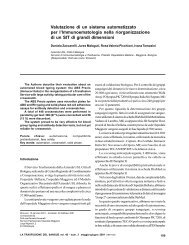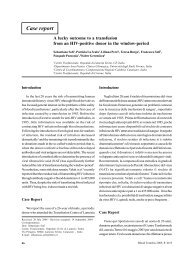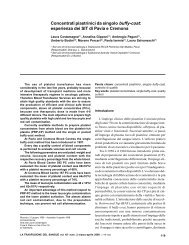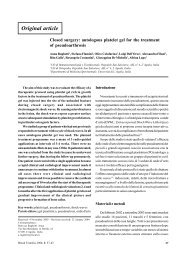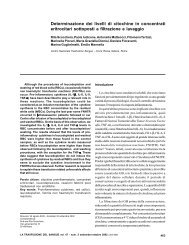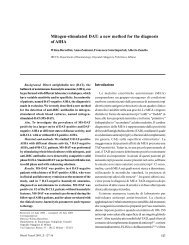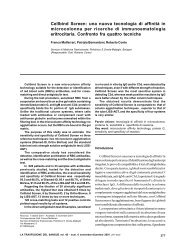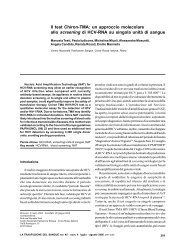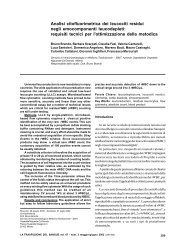Mathematics and transfusion medicine - Blood Transfusion
Mathematics and transfusion medicine - Blood Transfusion
Mathematics and transfusion medicine - Blood Transfusion
Create successful ePaper yourself
Turn your PDF publications into a flip-book with our unique Google optimized e-Paper software.
Bocciardo L et alTable II - Productive apheresis procedures carried out in the SIMTN. of plasmapheresis N. of plateletphersis N. of plasma-platelet Total n. of productiveprocedures procedures pheresis procedures apheresis procedures2001 882 922 0 1,8042002 1,041 874 0 1,9152003 727 288 671 1,6862004 808 0 975 1,7832005 866 3 887 1,756Table III - Distribution of plasma (in litres) in the period 2001-2005Total plasma Plasma for Class A plasma Class B+C plasma Totale plasmadistributed clinical use sent for industrial sent for industrial sent for industrialfractionation fractionation fractionation2001 1,520 245 267 1,008 1,2752002 1,619 286 308 1,025 1,3332003 1,621 250 360 1,011 1,3712004 1,774 290 461 1,023 1,4842005 1,864 260 508 1,096 1,604Litres of plasma200018001600140012001000800600400200024510082672861025308Figure 2 - Graphical representation of the distribution of theproduction of plasma in litresRequirements for blood derivativesTable IV reports the data on the consumption ofalbumin, intravenous IgG <strong>and</strong> antithrombin III in the yearsstudied. The graph in figure 5 illustrates the trends in thesame data, after normalisation to the values in 2001.250101136029010232001 2002 2003 2004 2005YearPlasma for clinical usePlasma B+C sent for industrial fractionationPlasma A sent for industrial fractionation4612601096508The overall normalised needs, obtained by summingthe specific needs, are also represented graphically.As can be seen from this latter graph, the overallrequirements are increasing constantly (with a mean annualincrease of about 6%), even if the specific requirements foreach plasma derivative are obviously dependent on thepopulation of patients in the corresponding year.In particular, it can be seen that in 2002, the maximumrelative need for intravenous IgG (8,445 g) correspondedto the minimum requirements for both albumin (34,190 g)<strong>and</strong> antithrombin III (386,000 U.I.); similarly, in 2004, aminimum relative need for intravenous IgG (6,476 g)corresponded to maximum requirements for both albumin(44,000 g) <strong>and</strong> antithrombin III (550,000 U.I.).Covering the needsStarting from the industrial technical yields (Table I), itis clear that the increased production of plasma in our SIMTimproved the theoretical coverage of the need for albumin,which increased from 82.6 % in 2001 to 91.6 % in 2005.The data on intravenous IgG were less comforting: thetheoretical coverage of needs, which in 2001 was 61.4 %,decreased to 54.2 % in 2005 (Table V).As far as concerns antithrombin III, we calculated that23.9% of the requirements were covered in 2005.It should be noted that this is a partial result in that88<strong>Blood</strong> Transfus 2007; 5: xx-xx DOI 10.2450/2007.0033-06085-92_bocciardi.p65 8805/07/2007, 11.20



